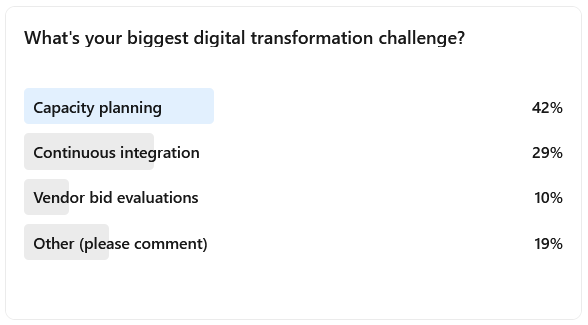Would you say it's resource capacity planning? Building continuous integration? Knowing if vendor bids are competitive? As a follow up to a recent post I shared on reducing uncertainty in digital transformation, I posed this question to my LinkedIn connections in a poll, giving them options I sourced from respected colleagues with experience in digital transformations. I also asked for suggestions not listed, in case there were challenges I might not have considered. I appreciated the great feedback I received and wanted to share the valuable insights I gleaned from the poll.

42% voted for “Capacity Planning” as their biggest challenge, 29% voted for “Continuous Integration,” 10% voted for “Vendor Bid Evaluations,” and 19% voted “Other."
Capacity planning was the most popular answer. No surprise there. Getting the right number of people with the right skill sets into the right places is almost always a challenge, especially on large programs with a lot of complexity. Staffing levels also have a direct correlation on the schedule, quality, and how much money will be spent. All of these factors need to be taken into consideration and communicated with stakeholders for a successful delivery. One of the ways that you can help manage this challenge effectively is by leveraging estimation and planning techniques that are based on historical data as part of your decision-making process. Asking questions like: "how have we staffed similar large programs in the past?" "What were the duration and effort numbers?" And "how much scope was delivered?" can help tremendously. If you don’t have that level of experience within your own organization, leveraging industry data along with empirically-based models can be very useful.
After capacity planning, the second biggest challenge according to the poll was continuous integration. We often hear about this issue with digital transformation, mainly because there are so many moving parts. Multiple applications being moved from physical to virtual environments and then making all of those systems work together can be extremely complicated. Just the development work alone on each program can be complex. One of the ways you can manage effectively here is by having a planning approach that lets you track at an organizational or macro level. This way you can see all of the moving parts and the impacts to cost, schedule, and quality.
Last, but certainly not least are vendor bid evaluations. Negotiating with vendors can be stressful, especially with digital transformation, because there are usually multiple vendors involved, often building multiple systems. A lot of the systems need to be integrated and tested and you’re dealing with many cost and schedule negotiations. Being able to measure the productivity of each vendor can be very helpful in these situations. Leveraging productivity, cost, and duration data from your own history, along with Industry, allows you to see if vendor bids are competitive. Once the vendors are chosen, it's important to track their progress and compare their actual productivity to what they promised. These types of analytics can give you the edge that you need to make early planning decisions, as well as critical in-progress decisions.
In addition to these technical challenges already mentioned, poll participants added "dealing with business process architecture" and "integration between the physical and virtual environment." Navigating the overall "size and scope of the transformation work" was another big issue that was mentioned and one that technology professionals often face.
I also heard about the non-technical side to digital transformation. Things like: "change management" and "active leadership engagement." One thing that stood out was how important communication is when managing digital transformation. Technology professionals understandably tend to focus on the technical side of things, but, ultimately it's the people running the technology. If we can find ways to manage expectations more effectively and improve negotiations early in the planning process, we can help these transformations go more smoothly.
The data-driven approach that I mentioned earlier not only helps with the technical side, but it can also help with the "people side" of a digital transformation. By leveraging just a few high-level metrics to predict the cost, schedule, and quality big picture and by getting everyone on the same page early, you will increase the chances of a successful delivery. This means, before detailed planning takes place, using empirically based models and historical data to establish what a reasonable budget and schedule should be. Once the targets are agreed upon, you can track the progress each month, so senior management and all of the stakeholders can be involved all the way through the process. No surprises. If requirements change, you can see it early and adjust. Of course, there are no silver bullets. But big picture analytics and using them the right way, not as a hammer, but as a negotiating tool, can go a long way to helping with the success of a digital transformation.
